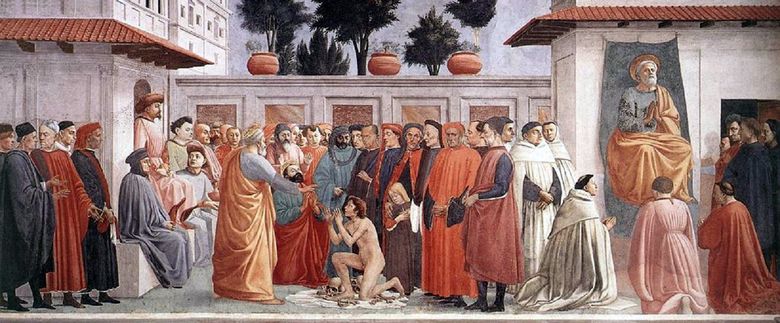
Masaccio in the mid 1420s a cycle of frescoes was ordered for the Brancacci Chapel in the church of Santa Maria del Carmine in Florence, describing the life of St.. Petra. St. Peter twice appears in the scene in which two episodes of the missionary journey of this apostle to Antioch are simultaneously depicted: the return of the son of the skeptical ruler Theophile to them and the subsequent enthronement of Peter by the citizens as their bishop.
On the Masaccio fresco, as witnesses of this miracle were probably depicted members of the Brancacci family. However, this fresco was rewritten by Lippi in the 1480s, and many of the original figures were replaced by portraits of Lippi’s contemporaries.
The bones under the legs of a kneeling boy indicate that he had long been dead when Peter resurrected him. ST. PETER. Peter, “the prince of the apostles,” occupies a special position among the disciples of Christ, and in iconography he always stands in a place of honor, at the right hand of Christ. Its importance is emphasized in the Gospels very often – for example, when Jesus agrees to allow him to go with him along the water.
After the Resurrection, Christ appears to Peter and commands him: “Feed My sheep.” Peter began to preach among the Jews, while St. Paul was among the pagans; it is believed that Peter was the first bishop of Rome. Peter is usually portrayed as a vigorous old man with curly gray hair and a beard; he often wears a yellow cloak over green or blue robes. Its usual attribute is two keys.
 La résurrection du fils de Théophile – Masaccio et Filippino Lippi
La résurrection du fils de Théophile – Masaccio et Filippino Lippi La resurrección del hijo de Teófilo – Masaccio y Filippino Lippi
La resurrección del hijo de Teófilo – Masaccio y Filippino Lippi Exile from Paradise by Masaccio
Exile from Paradise by Masaccio Lost paintings by Masaccio
Lost paintings by Masaccio Tribute Money by Masaccio
Tribute Money by Masaccio Madonna and Child with Saints Jerome and Dominic by Filippino Lippi
Madonna and Child with Saints Jerome and Dominic by Filippino Lippi Miracle with a statir (Payment of tax) by Masaccio
Miracle with a statir (Payment of tax) by Masaccio